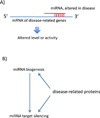MicroRNAs and neurodegeneration: role and impact
- PMID: 23026030
- PMCID: PMC3540990
- DOI: 10.1016/j.tcb.2012.08.013
MicroRNAs and neurodegeneration: role and impact
Abstract
Neurodegenerative diseases are typically late-onset, progressive disorders that affect neural function and integrity. Although most attention has been focused on the genetic underpinnings of familial disease, mechanisms are likely to be shared with more predominant sporadic forms, which can be influenced by age, environment, and genetic inputs. Previous work has largely addressed the roles of select protein-coding genes; however, disease pathogenesis is complicated and can be modulated through not just protein-coding genes, but also regulatory mechanisms mediated by the exploding world of small non-coding RNAs. Here, we focus on emerging roles of miRNAs in age-associated events impacting long-term brain integrity and neurodegenerative disease.
Copyright © 2012 Elsevier Ltd. All rights reserved.
Figures


References
-
- Orr HT, Zoghbi HY. Trinucleotide repeat disorders. Annu Rev Neurosci. 2007;30:575–621. - PubMed
-
- Ballard C, et al. Alzheimer's disease. Lancet. 2011;377:1019–1031. - PubMed
-
- Ferraiuolo L, et al. Molecular pathways of motor neuron injury in amyotrophic lateral sclerosis. Nat Rev Neurol. 2011;7:616–630. - PubMed
-
- Coelho M, Ferreira JJ. Late-stage Parkinson disease. Nat Rev Neurol. 2012 - PubMed
Publication types
MeSH terms
Substances
Grants and funding
LinkOut - more resources
Full Text Sources
Other Literature Sources
Medical

